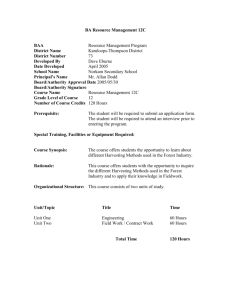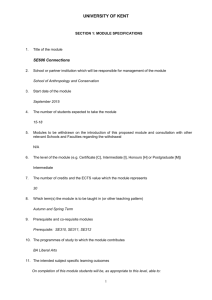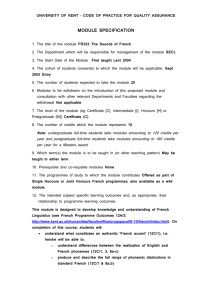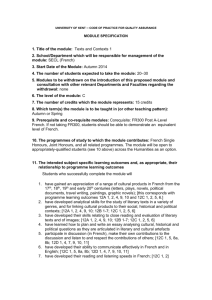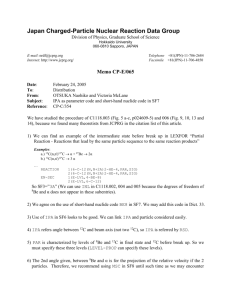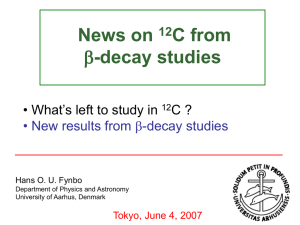LEDA / Lepton Scattering on Hadrons
advertisement
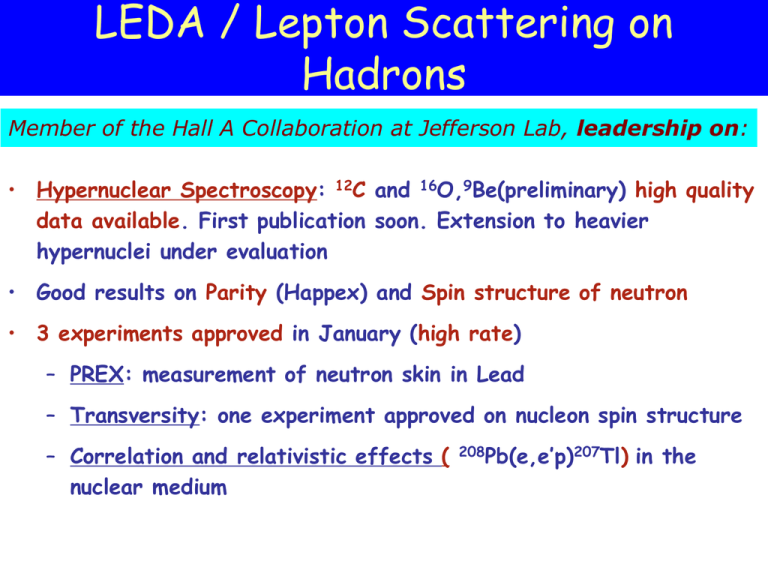
LEDA / Lepton Scattering on Hadrons Member of the Hall A Collaboration at Jefferson Lab, leadership on: • Hypernuclear Spectroscopy: 12C and 16O,9Be(preliminary) high quality data available. First publication soon. Extension to heavier hypernuclei under evaluation • Good results on Parity (Happex) and Spin structure of neutron • 3 experiments approved in January (high rate) – PREX: measurement of neutron skin in Lead – Transversity: one experiment approved on nucleon spin structure – Correlation and relativistic effects ( nuclear medium 208Pb(e,e’p)207Tl) in the ELECTROproduction of Hypernuclei at Jefferson Lab Hypernuclei are bound states of nucleons with a strange baryon (Lambda hyperon). Hypernuclear physics accesses information on the nature of the force between nucleons and strange baryons. A hypernucleus is a “laboratory” to study nucleon-hyperon interaction (L-N interaction). • The characteristics of the Jefferson Lab. electron beam, and those of the experimental equipments, offer a unique opportunity to study hypernuclear spectroscopy via electromagnetic induced reactions. A new experimental approach: alternative to the hadronic induced reactions studied so far. • Hyperon formation in neutron stars is controlled by the attractive hyperonnucleon interaction which can be extracted from hypernuclear data e e’ p K+ L Hall A facility: • Standard HRS spectrometers • 2 Septum Magnets for small angle • RICH detector for superior p / K / identification LEDA experiment is planning to complete a systematic study of high resolution spectroscopy on light and mediumheavy nuclei First RESULTS on 12C(e,e’K)12B 12C and 16O, 9Be 16O(e,e’K)16N L L Signal 7 Bckgnd nuclear targets: ~ 400 KeV L-interaction here is in p-state, poorly known…. Data will help in improving the model parameters (Spin-Orbit term of LN interaction potential) 9Be(e,e’p)9Li L Energy resolution ~ 700 KeV -the best achieved in hypernuclear production experiments, (improving) down to ~ 400 KeV -first clear evidence of excited core states at ~2.5 and 6.5 MeV with high statistical significance - possible thanks to the RICH detector and Septum magnets (INFN contribution), important devices for other experiments (parity, GDH..) and planned(Pb Parity, Transversity..) Models of elementary reactions fail in reproducing the data (Red, Bennhold-Mart (K MAID)) (Blue Saclay-Lyon (SLA)) Happex: “strangeness content of proton” Parity-violating electron scattering on proton and 4He Interference with Electromagnetic amplitude makes Neutral Current accessible . GEs = -0.12 ± 0.29 GMs = 0.62 ± 0.32 Strange form factors Longitudinal spin asymmetry violates parity (polarized e-, unpolarized p) anticipated precision Would imply that 7% of nucleon magnetic moment is Strange Improving precision Q2~0.1 GeV2 LEDA contribution for experiments in Hall A (performed and planned) Superconducting Septum magnets 12.5° 6 ° (>Mott cross section) QuickTime™ and a TIFF (Uncompressed) decompressor are needed to see this picture. RICH detector unambiguous K identification Pion rejection factor ~ 1000 PREX: Parity Violating Electron Scattering on Pb Investigation of the nucleonic matter properties • Equation of state of neutron rich matter • Symmetry energy of dense matter • Strong connection with neutron star properties Clean Measurement of neutron skin of lead by Left/Right Electroweak Cross Section Asymmetry: 2 e + Zz0 Fn Q 2 R L PWIA 2 ALR 1 4 sin W 2 R L Fp Q e As effective probe of neutron form factor Fn(Q2) Accurate neutron radius determination Experimental Aspects • CEBAF 80% Polarized Electron Beam • Lead Foil Target • Hall A Standard Spectrometers + Septum Magnets Single Spin Asymmetry of 3He(e,e’h±)X on DIS h K First Time Measurement of neutron Transverse Target Single Spin Asymmetry: AUT hl , Sl Sivers Collins AUT sin hl Sl AUT sin hl Sl l l l l 1 h ,S h ,S ST hl ,Sl hl ,Sl Physics Motivations: • Nucleon Spin Structure: information on (poorly know) transverse quark spin and (unknown) angular momentum contribution to the nucleon spin • Non-perturbative QCD: non-singlet transverse quark distribution function provides a clean Q2 evolution Experimental Aspects • CEBAF High Density Electron Beam • High Density Transversely polarized 3He target almost pure polarized neutron • 26 International Institutions involved • Approved experiment (Jlab) with highest rating • Expected to run 2 semester of 2007 • RICH Detector for scattered hadron (p/K) for 1 month identification Complementary to existing data (HERMES and COMPASS mainly) and unique for the coming years nd Impulse Approximation Limitation to 208Pb(e,e’p)207Tl reaction K. Aniol, A. Saha, J. M. Udias and G. Urciuoli Spokepersons Identifying correlations and relativistic effects in the nuclear medium The experiment will use 208Pb, a doubly magic, complex nuclei, a textbook case for the shell model, measuring 208Pb(e,e’p)207Tl cross sections at true quasielastic kinematics and at both sides of q. This has never been done before for A>16 nucleus Quasielastic kinematics: xB = 1, q = 1 GeV/c , ω = 0.433 GeV/c Determine momentum distributions: 0 < pmiss < 500 MeV/c Determine Transverse-Longitudinal Asymmetry ATL: 0 ATL Nikhef data at xB ~ 0.18 0 (1) First measurements in quasielastic kinematics on the paradigmatic shell model nucleus, 208Pb at high Q2. Accurate spectroscopic factors for separated shells will be obtained at several values of Q2. (2) Strength for pmiss > 300 MeV/c will give insight into nuclear structure issues and will settle the long standing question about the amount of long range correlations. They will be seen for the first time, if they are there. (3) A new observable ATL for the five low lying states of 207Tl will be measured. ATL helps distinguishing between relativistic and nonrelativistic structure of the wave functions. E94-107 Hall A Experiment Vs. KEK-E369 12C(e,e’K)12B L 12C( ,K+)12C L H. Hotchi et al., Phys. Rev. C 64 (2001) 044302 Statistical significance of core excited states: Signal 7 Bckgnd E94-107 Hall A Experiment Vs. FINUDA (at Dane) 12C(e,e’K)12B L Statistical significance of core excited states: Signal 7 Bckgnd 12C(K- , )12CL E94-107 Hall A Experiment Vs. HallC E89-009 12C(e,e’K)12B L 12C(e,e’K)12B L Miyoshi et al., PRL 90 (2003) 232502. New analysis Statistical significance of core excited states: Signal 7 Bckgnd E94-107 Hall A Experiment: status of 12C(e,e’K)12B 12B L data L Energy resolution is ~ 750 keV with not fully optimized optics for momenta reconstruction Work is in progress to further improve the resolution, hence the signal/noise ratio more checks and tuning have to be done, …but : the data are already of extremely good quality Statistical significance of core excited states: Signal 7 Bckgnd … to be published soon
